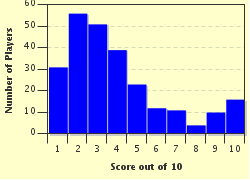Quiz Answer Key and Fun Facts
1. Sue Grafton's Milhone books: Grafton is halfway through her alphabetical Kinsey Milhone series. What is the title of the "M" book?
2. If music be the food of love, play on: Which composer had difficulty landing or staying in a job despite being considered one of the top composers of his time?
3. Languages of the world: This language of Papua New Guinea was spoken by about 300 people in the Madang Province in 1981.
4. Colour me curious: Who was the artist responsible for works including "The Absinthe Drinker" and "The Luncheon on the Grass"?
5. Give the dog a bone: Despite its small size, this fearless breed can overpower a wild boar, will guard a home yet is gentle with children.
6. The War of Secession (aka American Civil War): Which battle took place on 7 June 1863 and involved the African Brigade, two companies of the 10th Illinois Cavalry and the gunboats Choctaw and Lexington?
7. Towers and turrets: In 1786, Goethe was arrested. His purported crime? Espionage. His suspicious action? Making a drawing of a castle - but which castle?
8. Write on: This author's works influenced the major authors who followed him. He was a lawyer and town mayor - who was he?
9. Countries: Which country is slightly smaller than Connecticut, with a population of slightly under 700,000, and has five airports?
10. Rock on: Which mineral is a black variety of Andradite Garnet?
Source: Author
CariM0952
This quiz was reviewed by FunTrivia editor
Nannanut before going online.
Any errors found in FunTrivia content are routinely corrected through our feedback system.

